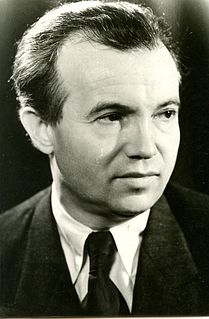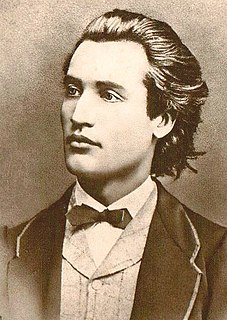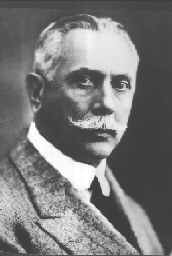 W
WVincențiu Babeș was an ethnic Romanian lawyer, teacher, journalist and politician from Hungary, and one of the founding members of the Romanian Academy.
 W
WAnton Costache Bacalbașa was a Romanian political journalist, humorist and politician, chiefly remembered for his antimilitaristic series Moș Teacă. Together with his brothers Ioan and Constantin, he entered public life as a republican and socialist militant. For a while, his career was intertwined with that of Marxist doyen Constantin Dobrogeanu-Gherea, who inspired in him the idea of a socialist art addressed to the masses. He was himself a popularizer of Marxist ideas, and one of the first Marxist intellectuals in Romanian political history.
 W
WGeorge Bacovia was a Romanian symbolist poet. While he initially belonged to the local Symbolist movement, launched as a poet by Al. Macedonski with the poem and poetry collection Plumb ("Lead"), his poetry came to be seen as a precursor of Romanian Modernism and eventually established him in critical esteem alongside Lucian Blaga, Tudor Arghezi, Ion Pillat and Ion Barbu or Octavian Goga as one of the most important interwar Romanian poets. In the 1950s, he wrote the poem "Cogito" which is his poetical testament.
 W
WAlecu Beldiman, common rendition of Alexandru Beldiman, also known as Alecul or Aleco Beldiman, was a Moldavian statesman, translator and poet, one of the forerunners of Romanian nationalism. A scion of the boyar elite, he was the eldest son of Vornic Gheorghe Beldiman, and the nephew-in-law of chronicler Enache Kogălniceanu. Alecu himself held high commission in the Moldavian military forces and bureaucracy, but secretly resented the Phanariote regime which had awarded them. He may have affiliated with a loose group known as the "National Party", championing an alliance between Moldavia's independence from the Ottoman Empire and support for the French Republic.
 W
WMihai Beniuc was a Romanian socialist realist poet, dramatist, and novelist.
 W
WGeorge Coșbuc was a Romanian poet, translator, teacher, and journalist, best remembered for his verses describing, praising and eulogizing rural life, its many travails but also its occasions for joy.
 W
WMihai Eminescu was a Romanian Romantic poet, novelist, and journalist, generally regarded as the most famous and influential Romanian poet. Eminescu was an active member of the Junimea literary society and worked as an editor for the newspaper Timpul, the official newspaper of the Conservative Party (1880–1918). His poetry was first published when he was 16 and he went to Vienna to study when he was 19. The poet's manuscripts, containing 46 volumes and approximately 14,000 pages, were offered by Titu Maiorescu as a gift to the Romanian Academy during the meeting that was held on 25 January 1902. Notable works include Luceafărul, Odă în metru antic, and the five Letters (Epistles/Satires). In his poems he frequently used metaphysical, mythological and historical subjects.
 W
WDaniel Ioniță is an Australian poet and translator of Romanian origin, who has been published bilingually in both Australia and Romania. Ioniță is known for his writing, especially poetry and poetry in translation, as well as for his cultural activity leading the Australian-Romanian Academy for Culture.
 W
WEugen Jebeleanu was a Romanian poet.
 W
WJeton Kelmendi is academic, Albanian journalist, poet, translator, university professor and political analyst.
 W
WUdriște Năsturel, first name also Uriil, Uril, Ioriste, or Oreste, last name also Năsturelovici, was a Wallachian scholar, poet, and statesman, the brother-in-law of Prince Matei Basarab through his sister Elena Năsturel. Together, the three staged a cultural revival centered on Bucharest and Târgoviște. Năsturel had risen through the ranks of Wallachian bureaucracy and had served Radu Mihnea's government in Moldavia, being kept as Logothete by Matei Basarab. In office, he had an international correspondence and went on diplomatic travels through Central Europe, while also overseeing the printing presses. He was the titular boyar of Herăști, known in his day as Fierești and Fierăști, where he built a palace that stands as a late example of Renaissance architecture, and earned him a regional fame.
 W
WGeorge Topîrceanu was a Romanian poet, short story writer, and humourist.
 W
WTristan Tzara was a Romanian and French avant-garde poet, essayist and performance artist. Also active as a journalist, playwright, literary and art critic, composer and film director, he was known best for being one of the founders and central figures of the anti-establishment Dada movement. Under the influence of Adrian Maniu, the adolescent Tzara became interested in Symbolism and co-founded the magazine Simbolul with Ion Vinea and painter Marcel Janco. During World War I, after briefly collaborating on Vinea's Chemarea, he joined Janco in Switzerland. There, Tzara's shows at the Cabaret Voltaire and Zunfthaus zur Waag, as well as his poetry and art manifestos, became a main feature of early Dadaism. His work represented Dada's nihilistic side, in contrast with the more moderate approach favored by Hugo Ball.
 W
WDuiliu Zamfirescu was a Romanian novelist, poet, short story writer, lawyer, nationalist politician, journalist, diplomat and memoirist. In 1909, he was elected a member of the Romanian Academy, and, for a while in 1920, he was Foreign Minister of Romania. Zamfirescu is best remembered for his Comăneștenilor literary cycle, comprising his novels Viața la țară, Tănase Scatiu, În război, Îndreptări and Anna.
 W
WTodur Zanet is a Gagauz and Moldovan journalist, folklorist and poet, one of the most prominent contributors to Gagauz literature and theater. He editor-in-chef of Ana Sözü newspaper, which cultivates the Gagauz language, and has written the original anthem of Gagauzia. His activity as a journalist began under Soviet rule, and first peaked during the Perestroika years, when he became involved with the Gagauz nationalist movement.